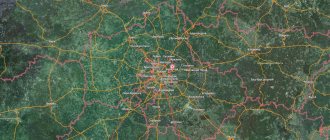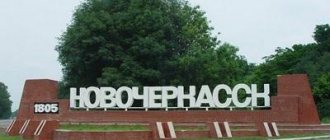Located in the western part of the Central Russian Upland, on the border with Belarus and Ukraine, Bryansk is a large administrative center of the Bryansk region and a city of regional significance with a population of more than 400 thousand people.
The city today is a large industrial and cultural center. Bryansk on the map of Russia is designated as an important transport hub, since a large number of both internal and external railways, airlines, and highways pass through it.
The city lies on both banks of the Desna and is surrounded by dense forests. It harmoniously combines the spirit of antiquity and modern trends. Even today it is called a partisan region, and the memory of the heroes who died for their Motherland still lives in the hearts of local residents.
From the history of Bryansk
Bryansk is rightfully proud of its more than thousand-year history. It was first mentioned in the chronicles of 1146 as Debryansk. The name comes from the word “wilds” and is explained by the fact that its territory was surrounded by impenetrable forests, in which, according to legend, the Nightingale the Robber lived.
Bryansk is a city with a difficult fate. He had to survive the Mongol-Tatar raids, fires, and the consequences of the struggle for power. The following events are particularly significant:
- 985 is the approximate date of the founding of Bryansk;
- 1356 – annexed to the Principality of Lithuania;
- 19th century - became the center of the industrial area of the same name;
- 1920-1929 - becomes the administrative center on the map of Bryansk province;
- 1930 - became a city of regional subordination;
- October 1941 - occupied by Nazi troops, became the center of the partisan movement;
- September 1943 – liberated from the occupiers;
- July 1944 becomes the center of the newly formed Bryansk region;
- 2010 – received the title of “City of Military Glory”.
Population[ | ]
| Population | ||||||
| 2002[12] | 2009[13] | 2010[14] | 2011[15] | 2012[16] | 2013[17] | 2014[18] |
| 450 289 | ↘430 172 | ↗435 245 | ↘434 560 | ↘432 033 | ↘429 940 | ↘427 357 |
| 2015[19] | 2016[20] | 2017[21] | 2018[22] | 2019[23] | 2020[24] | 2021[4] |
| ↘426 060 | ↘424 582 | ↗425 030 | ↘423 981 | ↘422 796 | ↘420 444 | ↘417 096 |
Bryansk on the map of Russia: geography, nature and climate
As you can see from the map, located on an area of about 23 hectares, the city is divided by the Desna River into right-bank and left-bank parts. Its two left tributaries - Snezhet and Bolva - create natural borders for three districts of the city: Fokinsky, Bezhitsky and Volodarsky. Another district - Sovetsky - is located on the steep right bank of the Desna. Looking at a map of Bryansk from a satellite, you can see what this city looks like from space.
The left bank of the Desna is a gently sloping lowland, the relief of the right is represented by small ravines and hills. The city is surrounded by dense forests, the area of which is more than 10,000 square kilometers. They are inhabited by various species of animals and plants.
Bryansk is located in a temperate continental climate zone, which is characterized by unstable weather in winter and warm, humid summers. The air temperature in Bryansk is, as a rule, 2-3 degrees higher than in Moscow.
In the winter months, severe frosts alternate with prolonged thaws. The thermometer stays within the range of -6-10 C. The temperature minimum (-41.8 C) was recorded in 1941.
In summer, the air warms up to an average of +22-25 C. The end of May is especially hot, as well as the end of July - August. It often rains with strong thunderstorms. The maximum air temperature recorded in 1936 was +38.4 C.
In autumn and spring, unstable weather with sharp temperature fluctuations prevails, which is explained by the proximity of Bryansk to the paths of movement of anticyclones and cyclones.
Climatic features of the city
Compared to many large settlements, Bryansk has a clear division into seasons in terms of climate. In addition, the air here is so clean and fresh that residents of other cities are very surprised when they arrive in Bryansk. And all this despite the fact that industry is well developed in Bryansk. This settlement is the center of various sanatoriums and recreation centers in the region. The reason for this is the wooded area.
The population of Bryansk districts with children strives to be closer to the Volodarsky district. This area of the city is considered the cleanest. There is less exhaust gas here. The only negative is the close proximity to the city dump. The city authorities have been thinking about building a waste treatment plant for a long time, but this issue still remains unresolved.
The weather here is changeable: although summer and winter keep their boundaries quite clearly, thunderstorms often occur in the spring and it can be windy. And yet, Bryansk is still popular, whose population loves their city for its cleanliness and freshness.
Routes on the map of Bryansk. Transport infrastructure
Bryansk is located 383 km from Moscow. The M-3 Moscow - Kiev , M-13 Bryansk - Kobrin , A-141 Orel - Rudnya highways pass through the city . Bus service is provided from the bus station located on Peresvet Street and the bus station in Bezhitsa. Bus services connect the city with Kaluga, Belgorod, Kursk, Orel, Smolensk, Lipetsk, and Tula. Simferopol, Gomel, Mogilev and Stary Oskol.
from three railway stations in the city - Bryansk-Orlovsky , Bryansk-Lgovsky and Ordzhonikidzegrad - on various routes. Railway lines to Moscow, Smolensk, Vyazma, Orel, Kyiv, Kharkov, Gomel are laid through the city. On the map the railway tracks are marked with a dotted line.
Public transport in Bryansk is represented by buses, trolleybuses and minibuses. More than 40 important urban routes are served by 295 transport units, many of which are physically and morally obsolete. Competitors to municipal transport are private minibuses operating on 40 routes. The fare is higher and differs between daytime and nighttime.
an international airport in Bryansk , it is located 14 kilometers west of the city. You can get there by bus No. 132B. There are only 6 bus trips per day.
How to get to Bryansk
The fastest way to get to Bryansk is by air. In summer, there are direct flights from St. Petersburg, Simferopol, Sochi, Gelendzhik and Anapa.
An equally comfortable, but longer journey is by train. A large number of intercity trains stop at the main Bryansk-Orlovsky railway station. From Moscow in the direction of Bryansk there are 4 direct daytime train flights and one night flight daily. There are also passing trains that connect Moscow with Gomel, Chisinau, Kiev and other cities.
For those who are used to traveling by bus, there are flights from Moscow, Belgorod, Gomel, Kursk, Kaluga, Orel, Tula, Smolensk, Lipetsk, Simferopol. Intercity buses arrive at the bus station on Peresveta St., 1A and at the bus station in Bezhitsa on Ulyanova St., 56A.
Car routes can be plotted on the map online. As a result, you will receive the shortest route to your destination, indicating the distance in kilometers, travel time and additional congestion of the routes.
You can also get to Bryansk by car. The federal highway M3 “Ukraine” leads to it from Moscow .
What is the connection between Chernobyl and Bryansk?
Few people know what happened in the city after the Chernobyl disaster. For a long time, authorities informed citizens that the radiation cloud had passed by Bryansk and the region. But the events immediately after the incident leave no doubt: all the people who were trying to travel towards Kaluga at that time had their gifts taken away, their cars were thoroughly washed several times, and they very meticulously inquired about where exactly and for what purpose the citizen was going.
Given the lack of trust in local city clocks equipped with a dosimeter, it is unknown whether background radiation is high in a populated area. This is the reason for constant recommendations to the local population to undergo fluorography of the thyroid gland annually.
Museums
It’s worth starting your acquaintance with the city with museums:
- The local history house museum , opened back in 1921. The exhibition consists of several collections: “History”, which presents monuments from different eras, “Nature”, which tells about the flora and fauna of the Bryansk region, and modern history, which contains exhibits dedicated to the partisan movement; address: Partizan Square, 6;
- BMZ People's Museum , the exhibition of which tells about the history of transport engineering in Bryansk, st. May Strike, 6;
- Literary Museum , located in an old merchant mansion and storing literary monuments of Ancient Russia, as well as exhibits dedicated to the works of F.I. Tyutchev, L.N. Tolstoy and other writers, Fokina St., 14;
- Museum of the Tkachev Brothers , storing more than 200 paintings by folk artists and other works of art, Kuibysheva St., building 2.
Employment
What level of unemployment and employment can Bryansk demonstrate? The city's population complains about the lack of enterprises with decent wages. Finding a job in Bryansk is not so difficult, but providing for your family is an almost impossible task. That is why many local residents are not limited to one source of income and earn extra money in their free time. If we talk about prices for goods and services, they differ little from those in the capital. An exception, perhaps, is the cost of transport and meat products.
The largest city-forming enterprise in Bryansk is a machine-building plant specializing in energy and transport engineering. The enterprise provides 7,000 jobs, and it is here that young specialists are sent after graduating from the Bryansk Technical Institute.
Arsenal is another large enterprise in the city, specializing in the production of special equipment, primarily asphalt pavers. This is a modern enterprise that keeps up with the times. Production volumes increase every year, workers receive stable wages, not bad for the city and region. The company cares about the safety and health of its employees, annually sending the best specialists to sanatorium and resort treatment. Children of employees relax in the best health camps in the region.
Local authorities need to focus their main efforts on increasing the birth rate in the region, combating mortality, and also providing city residents with jobs with decent wages. Otherwise, in the near future, only old people will live here.
Monuments of Bryansk
The history of the city is reflected in numerous monuments:
- monument to partisans who died during the Great Patriotic War, Partizan Square;
- memorial to the 1000th anniversary of Bryansk, dedicated to the Battle of Kulikovo, Pyatnitskaya St.;
- a monument to the poet F.I. Tyutchev, erected on the 130th anniversary of his death, the intersection of Lenin Avenue and Fokina Street;
- guns from Arsenal, the oldest factory in Russia, Pokrovskaya Gora;
- a monument to a lathe, dedicated to the hard work of young workers during the war, Pokrovskaya Gora;
- monument to soldier-drivers, dedicated to the feat of car drivers during the war, 122 km of the A141 highway.
Interesting places in Bryansk
It is impossible to form your own opinion about Bryansk without visiting such interesting places as:
- Pokrovskaya Mountain - the historical center of Bryansk with the ancient Kremlin and cathedral;
- Mound of Immortality - a monument to those killed in the Great Patriotic War, Central City Park;
- the house of the merchant Abraham, built at the end of the 19th century, erected in the spirit of Gothic architecture, Arsenalnaya, 6;
- Holy Trinity Cathedral - a modern symbol of the revival of Christianity, Lenin Ave., 58;
- Peter and Paul Monastery - the oldest Orthodox shrine in the Bryansk region with the icon and relics of St. Oleg of Bryansk, Kulkova St., 14;
- Tolstoy Park Museum - the central park of the city with a unique collection of wooden sculptures, Gagarina bldg., 33.
Interesting facts about the city and people
From the Cold War to the present day, a populated area has been on the list of the very first targets for a nuclear strike. This is explained by the fact that near Bryansk there is a classified facility - an air defense center. For the same reason, there are no bomb shelters in the city.
In ancient times, Bryansk had to endure a lot. During the Time of Troubles, the city was completely burned. And this happened because of the devotion of the residents to False Dmitry.
There is a park in the city that is included in the list of the best parks in the world. The Park Museum named after A.K. Tolstoy received this honor because of its beautiful wooden sculptures. In 1982, this place was included in a monograph on the most beautiful parks in the world.
In addition, the residents of Bryansk say a lot about their city’s drinking supplies. According to recorded data, citizens used to drink water from the Devonian Sea, which was rumored to be larger than the Black and Caspian seas combined. More than a million years have passed since this sea disappeared, but underground there were still reserves of water that had become desalinated. Only towards the end of the 20th century did this source begin to slowly run out.
Territorial structure of Bryansk
The administrative-territorial map of the city is divided into 4 districts:
- Bezhitsky (northern part);
- Volodarsky (eastern part);
- Sovetsky (western part);
- Fokinsky (south-eastern part).
The largest district of Bryansk, Bezhitsky , is the industrial center of the city, as three factories are located here. The BMZ Palace of Culture is the main concert venue of the city. Divided by Liteiny Bridge into two parts.
Volodarsky is a “dormitory” area. It includes the village of Bolshoye Polpino. In the area there is a railway station, the Salyut cinema and a puppet theater, as well as several industrial enterprises.
Sovetsky is the central district of the city with a diverse residential complex: from high-rise buildings to the private sector and garden societies. Administrative buildings are located on Lenin and Karl Marx squares. The area is the center of cultural life of Bryansk.
Fokinsky district , which includes the village of Belye Berega, combines both residential areas and industrial zones. The longest street in Bryansk, Moskovsky Prospekt, . This area is distinguished by an abundance of greenery, as well as beach areas on Lake Mutnoye and the Snezhka River.
Infrastructure of the settlement
The city is predominantly filled with buildings from the Khrushchev era. In some places in Bryansk there are also “Stalin” cars. Simultaneously with the existence of rather old residential complexes, new villages are being built, and the population of the city of Bryansk is quite successfully building private houses.
As you know, today, on the site of the old airport, construction of an impressive microdistrict has begun, this facility is called the Priozerny village. In all respects, this is an excellent housing option - in the immediate vicinity there are shops and all the necessary service points. In addition, in terms of picturesqueness, this site surpasses most of the already existing residential complexes in a city like Bryansk (the population is trying to buy housing there now).
Main streets of Bryansk
- Rechnaya street on the map is located in the Volodarsky district. It starts at the intersection of Nikitinskaya and Kalinin streets and stretches along the banks of the Desna between picturesque hills and green areas of the city. There is a railway on the right side of the street. On Rechnaya there is a unique monument - Steam Locomotive ER78870. Rows of new buildings and industrial facilities line the street.
- One of the main streets of the Sovetsky district is Bezhitskaya . It originates at the intersection of Delegatskaya and Pogranichnaya streets and stretches to the intersection of Krakhmalev and Duki streets. Residential buildings and infrastructure facilities are located along it. Among the attractions that are located on this street, it is worth highlighting BSU named after. I.G. Petrovsky and the monument to the Teacher, installed next to the university.
- The history of Kalinin Street in the Sovetsky district goes back to ancient times. Its name changed somewhat, the last one it received in 1956 in honor of M.I. Kalinin. The street stretches on the right bank of the Desna from southwest to northeast for 5.6 km. As you can see from the map, it begins at the intersection of Moskovsky Prospekt and Krasnoarmeyskaya Street and connects the center of Bryansk with its left bank part. Many historical buildings have been preserved here, as well as shops, hotels, and cultural institutions.
- In this area there is another major city highway - Lenin Avenue . It starts from Krasnoarmeyskaya Street and goes to Duki Street. Life on the avenue does not stop either day or night. There are many shops, restaurants, hotels, a stadium and a circus, a library and educational institutions. The abundance of green spaces and interesting architecture make the avenue one of the most beautiful streets in Bryansk.
- Fokina Street intersects with Lenin Avenue , which starts from Krakhmalev Street and ends at the intersection with Kalinina Street. There is a monument to F.I. Tyutchev, a Literary Museum, a drama theater, as well as residential buildings and infrastructure. A map with houses will allow you to quickly and easily find the desired object.
- The main artery of the Fokinsky district - Moskovsky Prospekt - originates from Kalinin Street. As you can see from the map, along the highway there is an overpass across the railway tracks. Here is the Church of the Ascension of the Lord, a monument to I.I. Fokin, whose name the area bears, residential buildings and infrastructure.
Celebrities associated with Bryansk
Many people remember the pilot Valery Chkalov. But few people know what exactly connects the famous person with Bryansk.
In this city, the pilot made his flight under power lines. The maneuver was not completely successful; the manned vehicle crashed. Nevertheless, the pilot remained alive and unharmed. For such a risky flight, Chkalov was expelled from the army and sent to prison for a year. Voroshilov rescued him from there. Soon after his release, Valery Chkalov repeated his encore flight under the bridge. This time it was successful.
If we take into account modern celebrities, then Ksenia Sobchak will serve as a good example. As a child, she often spent time in this city. Her grandparents live here. By the way, Ksyusha’s grandmother is the former director of the Oktyabr cinema.







